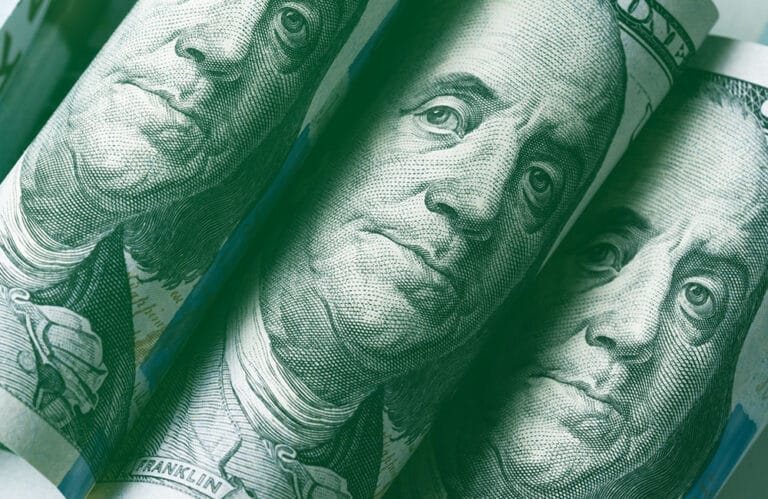
From Chief U.S. Economist PGIM Fixed Income, Tom Porcelli.
PGIM Fixed Income conducted analysis based on the potential election scenarios and their estimated impact on inflation, growth, and the fiscal deficit. Specifically looking at four key areas—trade and tariffs, fiscal policy, immigration and labor supply, and monetary policy effects—with significant economic impacts.
Trade and Tariffs
Harris—Assuming general continuity with Biden/Harris administration
- The Harris campaign is generally less vocal on trade issues, and we assume relative continuity with the current administration.1 This includes the general policy of “small yard, high fence” with strategic support/protectionism of “key sectors.”
- At this point, we expect targeted trade actions (i.e., tariffs, export controls) against specific countries, most notably China. This is unlikely to amount to a significant impact on the macro outlook.
Trump—The “Tariff Man”
Trump has floated a wide range of policy proposals, making the analysis of potential outcomes challenging, therefore our analysis includes the three tariff proposals below.
- Increased tariffs of up to 60% on China. While this proposal could be interpreted many ways, we assume the result would be a 60% effective tariff rate on imports from China. This could be implemented in two ways. The official campaign proposal is to revoke China’s Permanent Normal Trade Relations (PNTR) status. This would automatically raise the effective tariff rate to ~60% and would require legislation to pass Congress, which appears more likely under the Republican Sweep scenario.2,3 The other implementation method would utilise one or more existing trade authorities (i.e., Section 301, 232, or IEEPA) to reach an effective tariff rate of 60%, which would only require executive action and could be implemented relatively quickly.4,5
- A 10% universal tariff.6 Similar to the proposed tariff rate on China, we read this as reaching an effective tariff rate of 10% on all U.S. imports. There are also two general paths to implementation. The first would utilise existing executive authority, likely IEEPA and/or Section 301. The second strategy would seek passage of the “Reciprocal Trade Act,” which would raise tariff rates to match those levied against U.S. exports.7 This may be coupled with executive actions to reach a 10% effective rate on all U.S. imports.8
- Ad-hoc tariffs could lift the effective rate on all imports by 2 percentage points. Trump has floated numerous tariff proposals ranging from 10-200% on a variety of products and countries. While the lack of details makes it impractical to assess the individual impact of each, it is reasonable to expect additional tariffs separate from the preceding proposals. We assume this would follow the general strategy of Trump 1.0, the result of which was a 1.4 percentage point increase in the effective tariff rate in the first few years of his term.9
Also read: Opportunities Resonate Across DM Yield Curves: Amundi
Fiscal Policy
- Regardless of the ultimate election scenario, the incoming government will inherit a difficult fiscal situation.
- Unchecked growth in mandatory and discretionary expenditures, multiple stimulus packages before and in response to the pandemic, and rising interest costs have helped push fiscal deficits in excess of 5% over the foreseeable future under CBO baseline projections.
- Although fiscal policy is to likely remain expansionary in any scenario, its composition could differ substantially.
Immigration and Labor Supply
- The influx of immigration leading to above-trend growth in the non-U.S. born labor force has been a critical aspect in the outperformance of the U.S. economy over the last few years.
- However, there is considerable risk that this trend could change under various policy outcomes.
Monetary Policy Effects
- The next president will have the opportunity to appoint two Governors, one being the Chair and the other being the Vice Chair for Supervision. These appointees require Senate confirmation.
- The President will be able to nominate two of the twelve voting members of the FOMC. And while we certainly don’t want to downplay the influence of the Chair or the significance of an FOMC member, this is unlikely to radically shift the direction of the FOMC.
- Finally, significant changes to the Federal Reserve (i.e., mandate, structure, etc.) could only be achieved through legislative action. Given the razor thin margins in both “Sweep” scenarios, we think the hurdle is high to see significant Fed reform.
Potential scenarios and the impact on the macro economy
- The election scenarios show relative policy stability and minimal deviation from the base case under a Harris Presidency. As such, our 2025 outlook would appear largely unchanged.
- Under a Trump 2.0 Presidency, there would likely be a negative growth shock and upside inflation in response to tariffs, the level of which remains unclear. No surprise, but this is the key variable in these potential policy outcomes.
- This remains regardless of the composition of Congress and could be the dominating macroeconomic driver through at least 2025.
- The case could be made that under either a minimum or maximum tariff outcome, the Fed would be more concerned about the negative impact on growth and labor-market conditions as opposed to the temporary inflation shock.
- Therefore, the Fed may end up accelerating its cutting cycle under a Trump Presidency regardless of the fiscal response. With the current odds of ~50% of this outcome, the probability of more Fed cuts in 2025-26 may increase.
Harris + Divided: Similar Government, Similar Policies
- This includes mild growth and inflation pressure from a tightening of immigration restrictions and the subsequent slowing in labor force growth.
- Tighter fiscal conditions could start in 2026, as only a partial extension of the TCJA and limited discretionary spending cuts result from a divided government.
Democratic Sweep: Fiscal Deficits Remain Wide
- In 2025, we expect marginal deviation from our base case due to policy decisions.
- Starting in 2026, we would expect fiscal deficits to remain elevated around 6% as partial extension of the TJCA and increased spending is only modestly offset with increased revenue.
Trump + Divided: It Depends on Tariffs
- This scenario depends largely on the effective tariff rate that Trump may implement and when.
- The tariffs themselves are stagflationary, putting downward pressure on growth and upward pressure on inflation.
- This would put the Fed in a tough situation. It could look past the year-long temporary upside to inflation and provide supportive policy for growth.
Republican Sweep: Stagflation or Weakflation?
- The Republican Sweep scenario is similarly determined by what the Executive Branch does with tariffs.
- Max tariffs would provide a stagflationary shock, while minimum tariffs reduce growth and raise inflation for the first year of implementation.
- But in this scenario, we would expect some fiscal response from a unified government. A full extension of the TCJA and another cut to the corporate tax rate, likely to 15%, provides marginal upside to growth.
- We would then expect a larger fiscal response in 2026 as the negative growth from tariffs becomes apparent and the inflation shock begins to roll off.

































